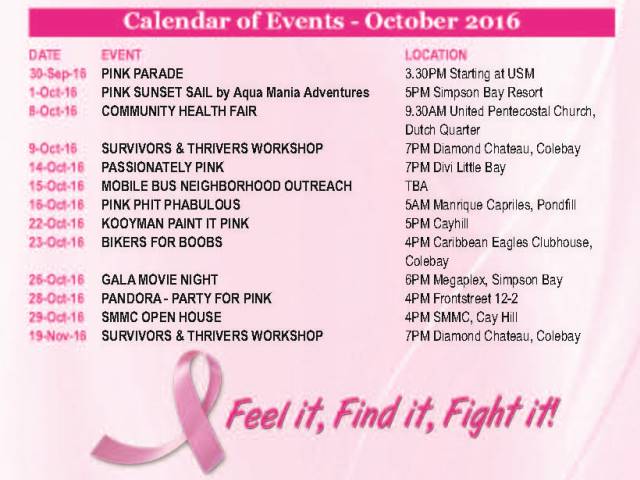GREAT BAY, Sint Maarten (DCOMM) – Breast cancer is among the most common cancers in women in the Americas, where approximately 408,000 women were diagnosed and 92,000 women died from breast cancer in 2012.
The ways to detect breast cancer early are through a monthly Breast Self-Examination and a yearly Breast Examination by a doctor. After age 50, one should also go for mammography every two years.
Collective Prevention Services (CPS), a department from the Sint Maarten Ministry of Public Health, Social Development and Labour, commends various organizations and institutions that have established campaigns to create awareness about Breast Cancer. In various countries around the world October is also recognized as Breast Cancer Awareness Month.
Breast cancer detected early and can be treated effectively. Breast health awareness programs can increase women’s understanding of their risks and of the signs and symptoms that need prompt medical attention.
Organized breast cancer screening programs can detect cancers at earlier stage. Most women diagnosed with early stage disease (I and II) have a good prognosis, with overall five-year survival rates of 80-90%.
CPS encourages all women to take the opportunity made available to visit clinical breast exam screenings which are currently underway. Several screenings are taking place at various clinics onOctober 5, 6, 7 and 8, and will continues on a weekly basis until the end of the month.
Breast cancer is the most common cancer affecting women. It can also affect men.
Breast cancer is a disease in which abnormal cells in the breast tissues multiply and form an invasive (or malignant) tumour. Not all tumours are invasive, some are benign tumours that are not life-threatening, whereas others are called lesions because they are contained in the milk ducts and have not invaded the surrounding tissue.
It is important to know the normal look and feel of your breasts. Things you should look out for include: a new lump or lumpiness in your breasts, especially if it is in only one breast; a change in the size and shape of your breast; a change to the nipple such as crusting, an ulcer, redness or the nipple pulled in; a change in the skin of your breast such as redness or dimpling or puckered skin; and a pain that does not go away.
Most breast changes will not be due to breast cancer but you should get them checked. If you notice a change in the look or feel of your breasts, even if your screening mammogram was normal, see your doctor without delay. The symptoms of breast cancer depend on where the tumour is in the breast, the size of the tumour and how quickly it is growing.
Breast cancer is both rarer and more difficult to detect in men of any age and the harms of screening mammograms are currently assessed as outweighing the benefits. For this reason men of all ages are instead encouraged to report any changes or concerns they have about their breasts to their doctor.
For more information about breast cancer, you can call CPS 542-2078 or 542-3003.






























